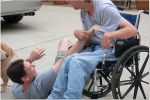This past Friday, Megan and I attended one of her favorite literary events (Osler Literary Roundtable at Duke). This week happen to be an open reading where several of us had the possibility to share our work and receive critique. This was a wonderful opportunity, as I have not had the pleasure of being in workshop with my own material since finishing college.
As Megan and I have been revamping the great majority of some of our own writing, I took the chance to share a piece from a collection that we are collaborating on. After reading the piece aloud, I was looking forward to having several sets of critical eyes offer some constructive feedback on the piece.
To my surprise, however, the first comment that arose was, “I’m confused, do you ambulate when you train in martial arts or was this at a time when you were more ambulatory?”
Though it is not uncommon for people to be puzzled when I mention training in the martial arts, I was somewhat surprised (and amused) by how the question was phrased. “I don’t need to ambulate to train!”
I replied, with a smile. As I think about it now, I realize that I take for granted many of the ways that I have navigated my physical situation to design my ideal life.
While I understand that, at first glance, most people see the physical aspects of who I am and therefore assume my disability defines my approach to life. Yet, I’ve found that much of life success is founded upon personal prospective and one’s ability to find creative solutions to the challenges we face. In the case of martial arts, I found myself training in a school that emphasizes the cultivation of heart combined with exploring how to use one’s natural body movement to survive dangerous situations rather than forcing the body to fit a prescribed mold.

